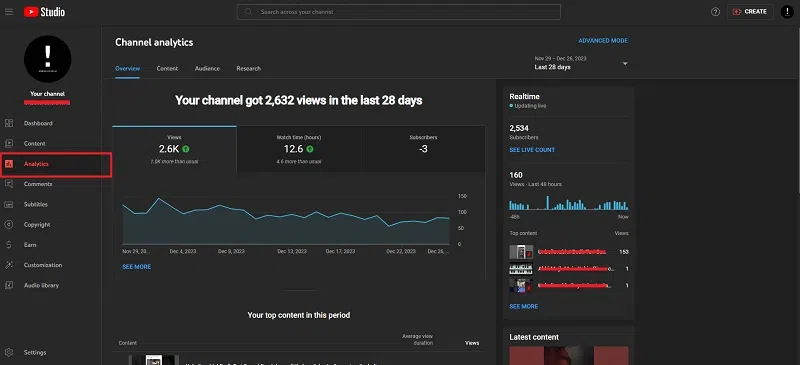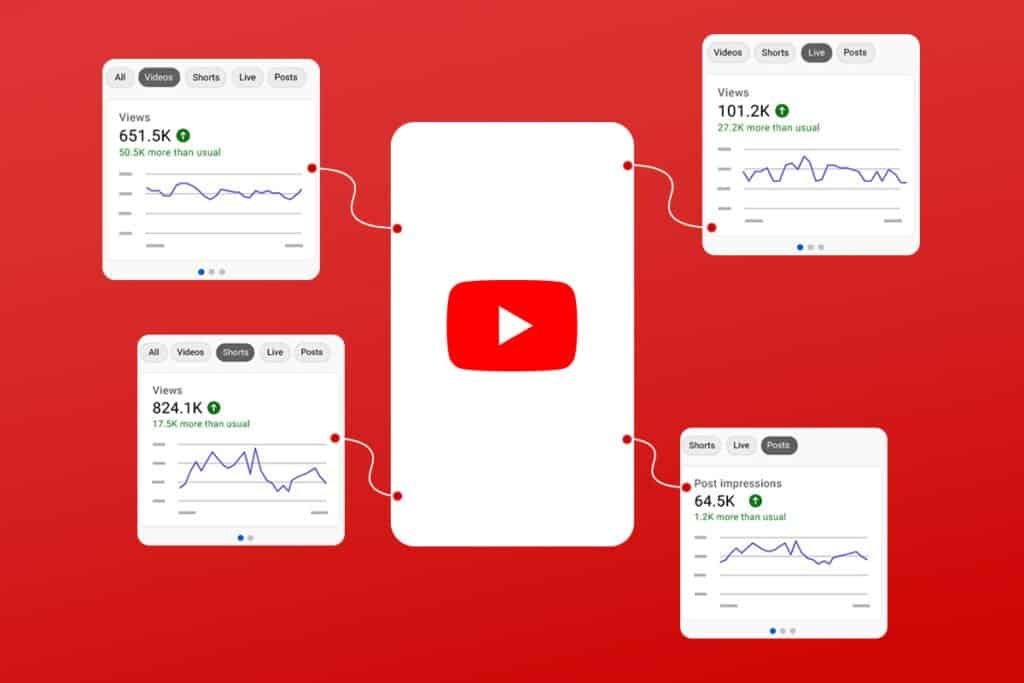What’s up bro! So, you’re a small YouTuber, grinding away, pouring your heart and soul into content, but feeling like you’re shouting into a void? You’re not alone. Many creators struggle to understand the YouTube algorithm and how to use analytics to their advantage. But fear not! This guide will equip you with the knowledge and strategies to master your YouTube analytics, boost your content, and grow your channel like never before.
Decoding the YouTube Algorithm: It’s All About Viewer Enjoyment
Forget outdated notions of subscriber counts and viral trends. The key to cracking the YouTube algorithm lies in understanding what YouTube truly values: viewer enjoyment. According to Roberto Blake, viewer enjoyment is the core metric that YouTube aims for.
YouTube Analytics 101: Your Secret Weapon for Growth
YouTube analytics can feel overwhelming. Here’s a breakdown of the essential metrics and how to use them:
1. Audience Demographics: Know Your Viewers
- Age, Gender, and Geography: While basic, this data offers a starting point. However, don’t stop there.
- Preferences and Culture: Delve deeper to understand your audience’s interests, values, and the other channels they watch. What formats does your audience prefer?
2. When Your Viewers Are Online: Timing Is Everything
- Identify Peak Activity: Discover when your audience is most active on YouTube to optimize your posting schedule.
- Strategic Posting: While on-demand viewing is common, posting during peak activity can boost initial views, especially for live streams.
3. Unique Viewers: The Metric That Matters
- Focus on Real People: Unique viewers represent the estimated number of real people watching your content.
- 90-Day Cycles: Analyze patterns over 90-day periods for more accurate insights.
4. Content Tab: Uncover Your Best Performers
- Format Breakdown: Analyze performance by content type (videos, shorts, live streams).
- Traffic Sources: Understand how viewers find your videos for each format.
- Suggested Videos: A win for live streams.
- Search: Often dominates for regular YouTube videos, especially tutorials.
- Shorts Feed: Key for shorts.
5. Revenue Tab: Monetize Like a Pro
- Multiple Income Streams: Explore options like YouTube Shopping, affiliate marketing, Super Chats, and ads.
- RPM (Revenue per Mille): Identify high-earning content categories and niches to inform your content strategy.
- Optimize for Revenue: Tailor content around topics with the highest RPM to maximize earnings.
6. Overview Tab: Real-Time Insights
- Real-Time Analytics: See what’s driving traffic to your channel in real-time, even older videos.
- Top 10 Videos: Identify top performers and inform future content decisions and titles.
Content Strategy Secrets: What to Make and How to Optimize
1. Replicate Success: Capitalize on Top Performers
- Identify Winning Themes: Analyze your best-performing videos from the last 90 days and create similar content.
- Traffic Source Optimization: Tailor your content to specific traffic sources based on format.
2. Search-Friendly Content: The Power of Tutorials
- Tutorial-Based Content: Create tutorials, especially for regular videos, as they perform well in search.
- Long-Tail Keywords: Optimize for search by targeting specific keywords.
3. Audience Engagement: Ask and You Shall Receive
- Questions of the Day: Posing questions can give viewers a reason to engage
4. The 15 Tips Strategy: Easy Content, Big Results
- Listicle-Style Videos: Create “15 Tips” videos for a low-lift, high-performing format.
- Subscriber Conversion: These videos can significantly boost subscriber acquisition.
5. Data-Driven Decisions: Let Your Analytics Guide You
- Video Groups: Group videos by topic to analyze performance and identify trends.
- Subscriber Filtering: Filter videos by subscriber gain to optimize around the most effective content.

The Truth About Subscribers: They’re Not Everything
Many YouTubers fixate on subscriber counts, but Blake emphasizes that views drive subscribers, not the other way around. Subscriber count is more of a status metric. Most views come from non-subscribers. A high percentage of views from non-subscribers is normal.
Posting Frequency: Consistency is King
- Direct Correlation: More frequent posting leads to more views.
- Two-Week Rule: Gaps longer than two weeks can negatively impact your channel.
- Viewer Behavior: Consistent uploads keep your audience engaged and prevent them from shifting to other channels.
- Sweet Spot: For many channels, publishing three to five times a week is ideal.
The Art of the Title: Clickthrough Rates and Long-Term Success
- Patience Pays Off: A video can underperform initially but gain traction over time.
- Double-Digit Clickthrough Rates: Aim for high clickthrough rates, even if it takes time for YouTube to find the right audience.
Quality vs. Quantity: Finding the Right Balance
- Quantity for Growth: Many niches benefit from consistent, high-value content, even if it’s not always exceptional quality.
- Acceptable Threshold: Focus on an acceptable level of quality and prioritize frequent uploads.
- Incremental Improvement: Let quality improve gradually over time.
The Mindset Shift: From Passion Project to Strategic Business
- Treat YouTube Like a Job: If you want to make a career out of YouTube, approach it with the accountability and discipline of a job.
- Required vs. Desired: Focus on creating content that performs well, even if it’s not your personal favorite.
- Data-Driven Decisions: Base your content strategy on data and outcomes, not just personal preferences.
Monetization Beyond AdSense: Diversify Your Income Streams
- Don’t Be a Digital Sharecropper: Don’t rely solely on AdSense revenue.
- Multiple Income Streams: Diversify with sponsorships, affiliate marketing, merchandise, and other opportunities.
- The Client Services Model: Consider offering your skills as a freelancer or consultant for a more immediate income stream.
The Success Spectrum: Measuring Your Progress
- Objective Measurements: Use objective metrics to track your progress and define success.
- Realistic Goals: Focus on achievable milestones, like monetization, consistency, and reaching specific view or subscriber counts.
- Niche Comparison: Compare yourself to other creators in your niche, not the YouTube giants.
Time Management and Efficiency: Work Smarter, Not Harder
- AI-Powered Editing: Leverage AI editing tools to streamline your workflow and save time.
- Batch Recording: Record multiple videos at once to maximize efficiency.
- Outsourcing: Delegate tasks like editing to free up your time for content creation and strategy.
The Dangers of Overthinking: Action Bias is Your Friend
- Just Do It: Don’t get paralyzed by the quest for the perfect video idea.
- Action Over Analysis: Take action and create content, even if it’s not perfect.
YouTube is a Battlefield: How to Win the War
- Stop Trying to Have Fun: Acknowledge that winning in a competitive environment is not fun.
- Success if for Older People: Young people optimize for “get rich quick.” Older people optimize for “slow and steady wins the race.”
- YouTube Pre-Selection Bias: Realize you are only seeing the outliers who have already achieved success.
Real Talk: YouTube Isn’t for Everyone
- Hobby vs. Career: If YouTube is primarily an emotional outlet, treat it as a hobby.
- Reasonable Expectations: Set realistic expectations and avoid turning your passion into a source of stress.
- The 9-to-5 Alternative: If you dislike your day job, focus on finding a better one rather than relying on YouTube as an escape.

Conclusion
Mastering YouTube analytics is not about chasing fleeting trends or obsessing over vanity metrics. It’s about understanding your audience, creating valuable content, and making data-driven decisions that propel your channel forward. By embracing the strategies outlined in this guide, you can unlock the secrets to YouTube growth and transform your small channel into a thriving hub of engagement, community, and success.
FAQs
Should I buy YouTube promotions to get seen? No. According to Roberto Blake, the promotion button was really designed for established brands and businesses.
How much money should a side hustle make? $300 to $500 a month. According to Roberto Blake, a side hustle in that range helps you to invest in yourself or buy assets.
Is it worth it to just have a Shorts channel? Yes, but you need to commit. You need to upload six to 12 Shorts per day to make money.

